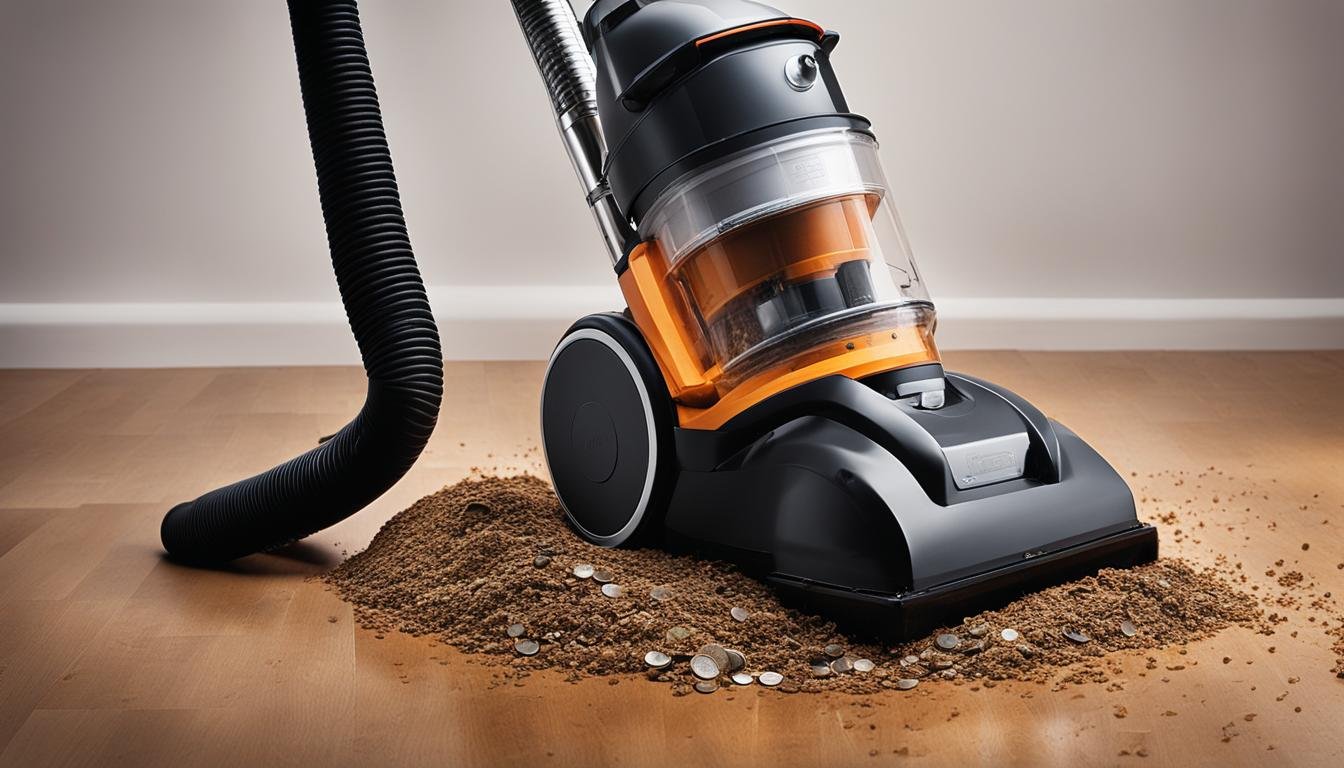When it comes to choosing a vacuum cleaner, suction power is a key factor to consider. A vacuum with good suction power ensures effective removal of dirt and debris from various surfaces. While manufacturers may not always highlight the suction power in their product descriptions, it is an important specification to evaluate.
So, how do you determine what is a good suction power for a vacuum cleaner? It all comes down to factors like motor power, airflow, and wattage. Vacuums with better overall performance tend to have good suction power. The Miele Complete C3, for example, is an excellent choice with its powerful 1200W motor and seven levels of suction power adjustment. Other options to consider include the Dyson Ball Animal 3, Miele Classic C1, Eureka Mighty Mite, and Dyson V15 Detect.
Key Takeaways:
- Good suction power is crucial for effective debris removal
- Factors such as motor power, airflow, and wattage determine suction power
- The Miele Complete C3 offers powerful suction with adjustable levels
- Other recommended options include the Dyson Ball Animal 3, Miele Classic C1, Eureka Mighty Mite, and Dyson V15 Detect
- Choosing a vacuum cleaner with the right suction power ensures a thorough clean for your home
Factors to Consider in Suction Power for Vacuum Cleaners
When choosing a vacuum cleaner, it’s important to consider the suction power, as it plays a crucial role in the overall cleaning performance. Here are some key factors to keep in mind:
Motor Input Power:
One of the primary factors to consider is the motor input power, typically measured in watts. Vacuums with higher wattage tend to have more powerful motors, resulting in better suction performance. Opting for a vacuum cleaner with a higher motor input power can ensure efficient cleaning.
Water Lift or Sealed Suction:
Another important factor to consider is the water lift or sealed suction. This measurement indicates how well the vacuum can pick up heavier soils and debris from surfaces. A higher water lift measurement generally indicates better suction power and effective cleaning.
Airflow:
Airflow is a critical specification to evaluate when considering suction power. It determines how effectively the vacuum can move dirt from surfaces to the dust bag or container. For canister vacuum cleaners, opting for a model with an airflow of 100 CFM or more is recommended, along with a water lift measurement of 90 inches or more. Upright vacuum cleaners have different designs, with direct air or dirty air models rated in amps, while bypass motor models have better airflow but may not provide water lift specifications. Ensure you choose a vacuum cleaner with excellent airflow to facilitate efficient dirt removal.
By considering these factors, you can make an informed decision when selecting the optimal suction power for your vacuum cleaner. Remember, a higher motor input power, greater water lift, and sufficient airflow contribute to better cleaning performance.
Conclusion
In conclusion, the suction power of a vacuum cleaner is a crucial factor in determining its cleaning performance. When choosing the right suction power for your vacuum cleaner, it is important to consider various factors such as motor input power, water lift, and airflow. These factors contribute to the overall cleaning ability of the vacuum cleaner.
The Miele Complete C3, Dyson Ball Animal 3, Miele Classic C1, Eureka Mighty Mite, and Dyson V15 Detect are all recommended options with good suction power. These vacuum cleaners offer reliable cleaning performance that can meet your needs.
By selecting a vacuum cleaner with the appropriate suction power, you can ensure an ideal cleaning experience for your home. Remember to prioritize a higher wattage motor, higher water lift measurement, and adequate airflow to achieve the best cleaning results. With the right suction power, you can effectively remove dirt, dust, and debris from various surfaces, leaving your home fresh and clean.
FAQ
What factors should I consider when choosing the suction power for a vacuum cleaner?
When selecting the suction power for a vacuum cleaner, factors to consider include motor input power (measured in watts), water lift or sealed suction, and airflow. These specifications will determine the vacuum’s overall cleaning ability.
Does a higher wattage motor in a vacuum cleaner indicate better suction power?
Yes, vacuums with higher wattage motors generally have more powerful suction performance. Higher wattage indicates a stronger motor, leading to more effective debris pickup.
What is water lift or sealed suction, and why is it important?
Water lift or sealed suction refers to the vacuum’s ability to pick up heavier soils and debris effectively. A higher water lift measurement indicates better suction power, making it easier to clean different surfaces.
How does airflow affect the suction power of a vacuum cleaner?
Airflow determines how efficiently the vacuum can move dirt from surfaces to the dust bag or container. Opt for a vacuum cleaner with excellent airflow, as it contributes to better overall cleaning ability.
Can you recommend vacuum cleaner models with good suction power?
Some recommended vacuum cleaner models with good suction power include the Miele Complete C3, Dyson Ball Animal 3, Miele Classic C1, Eureka Mighty Mite, and Dyson V15 Detect. These models offer excellent performance and reliable suction power.





Leave a Reply